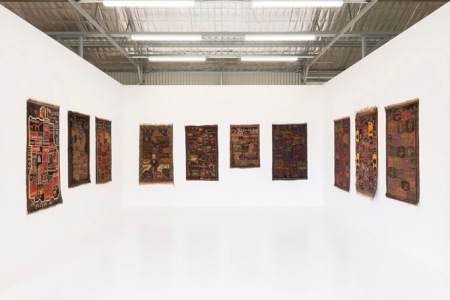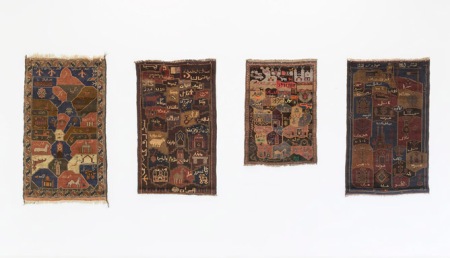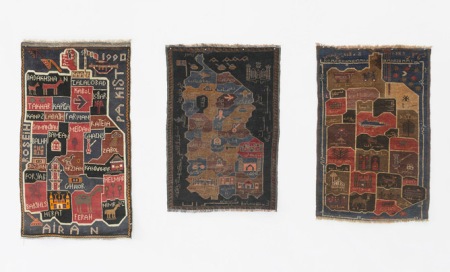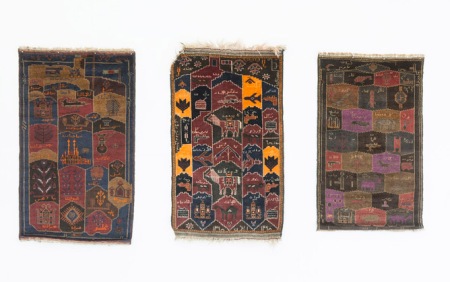
Perhaps it is only from the outside that one can decode aspects of the visual culture of a country like Afghanistan and formulate a proposition like “The Afghan Modern”. To propose an indigenous modernism within a distant culture is, inevitably, an act of cultural projection. And yet the bodies of work we have encountered beg the kind of formal analysis and iconographic interpretation that applies in any number of contemporary cross-cultural circumstances.

Afghan Modern @RKD is a small exhibition of ten conflict carpets from Afghanistan at Nigel Lendon’s studio space (@RKD) at Wamboin, near Canberra. The exhibition may be viewed by appointment (iconophilia@gmail.com) until 24th March.

The following essay summarises my thoughts about a group of Afghan conflict carpets produced in the years from 1988 to 1992, in which the dominant visual framing device is a map. Innovative in character, these carpets are distinct from other conventional uses of the map in the same medium during the same period, which I have written about elsewhere.[1] These particular examples are, I suggest, artefacts that collectively constitute an instance of a regional, or indigenous, modernism which has emerged independent of any cultural dependency or external influence, and which signals a break with the continuity of local traditions. In this sense, at least, it is like any other modernism.

What is the Afghan Modern? Who are its anonymous authors? And how does a concept of collective agency assist the analysis and interpretation of what these artists make? In this account I’m using the Modern to encompass both modernity and its modernist cultural forms within the one term, in a sense both to rehabilitate the term’s potential from before the historical critiques of anti-modernism and post-modernism, and, coincidentally, both on and off the new playing field of The Contemporary.[2]
For my usage of “modernity” I follow Charles Taylor’s account: “By modernity I mean that historically unprecedented amalgam of new practices and institutional forms (science, technology, industrial production, urbanization), of new ways of living (individualism, secularization, instrumental rationality), and of new forms of malaise (alienation, meaninglessness, a sense of impending social dissolution).”[3] However, I also reference another “modernity” – one that is most relevant to the very specific condition of Afghanistan – which is captured so perfectly by Anthony Giddens’ characterization of the ‘dark modernity’ of militarization.[4]
In its idiomatic usage, a modernist work of art conventionally suggests both innovation and reflexivity – whether in form, or subject matter, or, contra convention, a kind of art which breaks with tradition and proposes new forms of visualization in its particular social context. For Charles Harrison it was ‘the background noise of modernity’ that provides the impetus for the whole field of cultural transformations that encompass the evolutionary (and revolutionary) challenges to tradition that he identified with Euramerican modernism.[5] I therefore take the Modern to be all that which is consciously and reflexively engaged with modernity, in whatever innovative forms, in whatever medium, and in whatever cultural context in appears.
Mainstream art history finds it difficult to abandon its traditions. When John Clark claimed in 1998 that ‘it is an art historical fact that modernity in all Asian art cultures has developed out of contact with that of Euramerica’, he demonstrated how profound was the distance between such discourses and that of postcolonial historians such as Ian McLean et al.[6] And for Hans Belting, in his influential Art History after Modernism, the concept of art itself is restricted to a Western frame of reference: ‘There is the question whether tribal culture … has no art, even while its images display the highest artistic skill. They served other purposes like religion or social ritual, which may be more significant than creating art as we understand it.’[7] And in particular, for Belting, the ‘historical roots and cultural conditions’ of modernism are ‘only valid for the West.’ And yet he also admits ‘… we are so easily confused by art from other cultures that is obviously modern but equally obviously does not belong to our own history of art.’[8]
The emergence of the distinctively new forms of visual narrative in the wake of the Soviet invasion of Afghanistan in 1979 suggests a framework of modernity that necessitates the recognition of its social and historical specificity. In this essay therefore I propose the “Afghan Modern” as a cultural frame for the consideration of the conflict carpet that enables a revisionist reading in terms of conventional concepts of modernist art. I want to argue that it is rather the consequence of an enforced cultural alienation due to the circumstances of war and conflict, combined with the circumstances of anonymous authorship, when taken together with the collective mode of their creation, that cumulatively constitutes the challenges to the Eurocentric viewpoint. With the examples in this exhibition I will seek to show that it is both in the way they break with their own tradition as it is in the forms of representation of their narratives that these works are profoundly unconventional and modernist in character.
Thus my use of the Afghan Modern as a framing device enables me to focus on those instances of innovative developments which have taken place in this particular artistic medium – specifically in those new forms of the knotted carpet that are characteristic of indigenous Afghan contemporary art of the past three decades. My attention here is focused on examples drawn from the end of the decade of the occupation of Afghanistan by the Soviet Union, a period of production of distinctive cartographic imagery that both celebrated the defeat of the Soviets, and began to articulate a new kind of national identity for the Afghanistan that survived the period of Soviet occupation.
From the late 1980s, once Mikhail Gorbachev had announced the withdrawal of Soviet forces from Afghanistan, and despite the ongoing conflicts between the Najibullah regime and the mujahideen, there appears to have been a few short years of détente that enabled an unusually high level of production of “war rugs” and carpets that depicted the experience of war in a multiplicity of ways. Subsequently, in the period from 1992 onwards the onset of the horrific civil war that ultimately saw the destruction of Kabul and much else besides, the production of conflict carpets declined. This period ultimately led to the rise of the Taliban in the second half of the decade – with all of the consequences that arose from their patronage of al-Qaida, with the brutal enforcement of Sharia law, and all of its notorious iconoclastic consequences including the deliberate destruction of the Bamiyan Buddhas.
Conflict carpets pose a dual challenge to the neotraditionalist replication of past practices – which, in most cases, are designs which merely evoke tradition for commercial advantage. The conflict carpets may be seen as “modernist” insofar as they manifest both the traumatic experience of war and conflict, but also, in a kind of reflexive articulation, and in the specificity of their mode of production, they pose multiple challenges to their own ongoing tradition.
In the traditional mode of carpet-making there is a continuity of hierarchical structures of authority which maintains long-established modes of visual communication and continuities, or apparently so, as with the neotraditional forms. This is motivated by an understanding of its market (or a sense of an audience, as driven by market demand, primarily in the West) that perpetuates the forms associated with tradition and its antiquarian values and qualities. More and more, over the past half-century, such “traditional” artifacts were being made for sale to the outside world, rather than for local consumption.[9]
By contrast, modernist idioms in other visual media (graphics, architecture, transport, militaria) were increasingly widespread in Afghan culture from the late 1950s as a consequence of the modernizing policies of the government (then a kingdom) as new forms of communication emerged to convey the new political, social and economic realities of Afghanistan’s place in the world. However in the years following the Soviet occupation of Afghanistan (1979-1989) rugs began to be produced with a range of pictorial representations of the direct experience of war and conflict. It was not until 1988 that the so-called “war rugs” were first exhibited in any numbers in a European context. Notably, they were first shown (in contemporary art spaces, and other venues) by the Italian art historian, collector and curator Luca Brancati. Subsequently, through various commercial and non-commercial settings, more and more of these works found their way to the outside world – against all the odds, given the fraught circumstances of their production.
Such carpets embody characteristics that can be seen to make an image modern (in terms of its formal qualities) as well as modernist (in the self-reflexive sense of an intentional break with tradition). This is manifested firstly through their iconography – that is, their adoption of icons of modern life such as aeroplanes, vehicles, buildings, monuments, in figuration, portraiture, or the narratives of social experience. Secondly, they utilise new formats by introducing pictorialism, perspective, dimensionality, and asymmetry. Further, they combine image and text (in multiple languages), and often make use of a new colour palette. The intention of the authors to represent the experiences of Giddens’ “dark modernity” of the 1980s in one or more of these modes in turn stimulated new modes of cultural practices and perceptions about motivation and value, in the shift away from the traditionalist replicant mode of practice and production towards a genre of everyday reality.
One recognises such artefacts as “works of art” because they do the things one expects of art by presenting us with unfamiliar, unrecognisable or otherwise engaging characteristics, manifest in their qualities, their form, and their visual rhetoric. Both in their originating context, and in the outside world, such characteristics are nevertheless recognizable as advancing or challenging contemporary artistic and aesthetic issues. As an outsider, one conceives of such work as “modern” through the recognition of their novel form and content. Equally, this occurs as one comes to understand its critical relation to the processes of modernisation taking place around their production.
Thus whereas neotraditionalism is characterised by repetition, reiteration, and codification – producing emblematic, yet abstract forms – the Afghan Modern is here characterised by innovation (with new modes of representation, pictorialism, and figuration), or through narratives involving allegory, political rhetoric, and propaganda – all of which may be explicit (that is, didactic) or intrinsic to an abstracted mode of visual rhetoric. All of which had not previously existed in the repertoire of the carpet-maker.
Such developments do not appear out of nowhere. The historical context of Afghanistan in the 1960s and 1970s reveals how a visual culture of modernity was being experienced long before the Soviet invasion and was manifest in fashion, design, publicity, education, architecture, urbanization, industry, transport, and of course social conflict and the growing militarization of the state. It was certainly the case that such modernity was experienced more in Kabul than elsewhere, and in some parts of the country, hardly at all. As well, in such contexts, modernity was also manifested in mass social movements, the development of the nation state, and in the political rivalries of the cold war, followed by the neocolonisation imposed by Soviet annexation, subsequently overwhelmed by the guerilla campaigns of the mujahideen.
The images that begin to appear from 1989 onwards stimulate a rethinking of the potential and significance of the map emblem. In these examples of the reorientation (one might say disorientation) of the form of the map of Afghanistan, here rotated 90 degrees counter-clockwise, East becomes North, West becomes South, etc.. Therefore the Soviet Union (Roseih) is to the left, Iran (Airan) is below, Pakist (Pakistan) is to the right, and so on. By this re-alignment of the map to the long axis of the rug, the map loses its cartographic accuracy or relevance at the same time as it gains added symbolic significance and spatial complexity through its novel and ambiguous pictographic character.
Aligned to the (actual) Western border at the base of the carpet, the texts are both in Farsi and (sometimes) in Roman script – thus signaling that these are addressing both an internal and external audience. However the texts in this style of carpet are only ever place names, identifying the provinces and the neighbouring countries. Sometimes the text includes the date, or the attribution ‘Made in Afghanistan’. Symbols of the various provinces vary between examples – sometimes referencing architectural monuments, sometimes animals, sometimes military equipment. In some of these examples the Bamiyan Buddhas were still intact at the time these were made, and are shown as the familiar symbol of their province. Apart from the rotation of the map, to depict such details was a familiar element of postcards and tourist maps in the pre-war era.
In these examples the re-orientation of the 34 provinces of Afghanistan has produced a kind of vertical landscape – creating foreground and background spaces, with a high horizon line, providing space for buildings and aeroplanes, plus other illusionistic elements (flags), and other pictorial modes. Within this suggestion of the nation-as-landscape, the provinces relate to each other spatially, as well as creating the frames for the pictorial and architectural symbols, plus other decorative calligraphic effects, and in some cases the border texts in Farsi take the place of the overall frame of the rug. Precedents for this kind of vertical landscape are to be found both in the “floating perspective” of Chinese landscapes and the stylization of landscape forms to be found in Persian miniatures. In some cases the contrasting colours between figure and ground literally “float” the map of the Afghan nation as an isolated and self-sufficient entity.
The evolution of these maps towards a landscape form is affective in its evocation of national identity, suggesting character, resistance, and isolation – all seen as positive virtues – despite all of the ethnic complexities, rivalry, and conflict which are implicit in the complexity of the map form itself. However the civil conflict that burst on the scene in the years immediately after these rugs were made was to disturb this sense of national unity. Sometimes the symbols have retained their political significance, and so the Soviet Union (still intact at the time these were made) is still represented by the hammer and sickle.
All of these carpets can be attributed to the Aimak-speaking Hazara and Tajik people from the Ghor province, in the mid-western desert mountains of Afghanistan. While these carpets were produced in small numbers, and while comparing each with the others a degree of similarity is to be found, each example reveals individually different characteristics. With such engaging variants on the map-as-landscape, their different stylistic elements suggest they were made by different people, who followed verbal rather than visual directions of what was required. In addition, the degree of variation between examples suggests they were working from memory rather than from a cartoon, or from another rug.
The contrasting forms, colours, and materials tell us a great deal about the creative decisions made by their makers. Rugs of this scale are usually made by one person, and the way these are built, painstakingly working from bottom to top, reveals the narratives of their own production. Changes to field colour and texture (elsewhere called abrash) can be attributed to differences in availability, and in wool or dye batches. When it comes to materials and colours, war rugs are characteristically the result of unpredictable and opportunistic supply, which in the case of novel designs enables novel colour variations. Spontaneity, chance and variation together enabled innovative figures, forms and colours to emerge.
In the course of the evolutionary development of such images, a kind of progressive abstraction often occurs: in the structure of the final two maps of this series there is a development towards a more geometric schematization, and towards symmetry, which is the norm in traditional carpet design. In addition, in the final example, one finds a clue to the potential indigenous use-value of these rugs, whereby the map morphs into the architectonics of a prayer rug. In this example at top center one finds the directional form of the mihrab, containing the Hand of Fatima. Both suggest the use of these carpets in prayer, which, if true, may explain much of their counter-cartographic orientation.
Looking at such images, and following the build of a carpet from bottom to top, it is difficult not to imagine the experience of the individual maker: that is, of creative pleasure or the evidence of virtuosity we associate with the visual arts more generally. Their variable forms, the population of the empty space with animals, and their non-traditional colours, exemplify such aspects of the works. The carpets themselves also often reveal a process of progressive decision making (involving the specific nature of their forms, icons, emblems, and colour effects) which seems to reveal both the creative process and evidence of a capacity for individuals to create and innovate within the overall schema of the collective rug-making enterprise.
If one is to further explore the aspects of such works that pose problems for a Western sense of Modernism, then the most challenging aspect of the recognition of the so-called “war rug” as a form of contemporary art – or, one might propose, as Afghanistan’s Indigenous Modernism – is, I suggest, the absence of a singular artistic author. In the absence of such an archetype these artefacts are easily relegated to an inferior aesthetic status as “anonymous”, and/or as “craft”, given that the distinctive nature of their creativity is generally unfamiliar and alien to a Western audience. Such reactions occur irrespective of the context in which they are encountered, or whether they are exhibited in contemporary art spaces or ethnographic museums.
Afghan carpets are commissioned, designed, made and distributed under a distinctive schema of collective participatory production that involves numerous creative agents. Proposing that the products of communal authorship be recognised as “works of art” therefore necessitates a re-evaluation of the Western convention/expectation that a work of art normally has a unique author by which it may be identified and interpreted in art historical terms. Thus the recognition of a collective mode of authorship provides a Western audience with significant new insights into both concepts of creativity and the cultural values and protocols of this part of the Islamic world.
One further aspect which touches on the cultural specificity of these artefacts is their use-value in their originating context. The lengthwise rotated orientation of the map rug may suggest a vertical landscape, but, as I have noted above it also may also suggest the form of a prayer rug. Used in prayer, the implications of other kinds of abstracted signifiers causes one to think differently about the potential perception of form and space, and the symbolic values associated with the imagery, in its associated ritual usage, with eyes closed. This is also a reminder that such a modernism may assume culturally specific forms, as much applicable to worship as to trade.
Nigel Lendon
March 2016
[1] Nigel Lendon, “Beauty and Horror: Identity and Conflict in the War Carpets of Afghanistan,” in In Jaynie Anderson (ed.) Crossing Cultures: Conflict, Migration and Convergence. Melbourne: Melbourne University Press, 2008. pp. 678-683.pp.
[2] Arthur C. Danto, After the end of art: Contemporary art and the pale of history, PrincetonUniversity Press, Princeton, New Jersey, 1997. See also Terry Smith, “Contemporary art and contemporaneity” Critical Inquiry, 32, 4, Summer 2006.
[3] Charles Taylor, 2002 “Modern social imaginaries” Public Culture 14/1: p. 91
[4] Anthony Giddens, The Consequences of Modernity, Stanford: Stanford University Press, (1990:9).
[5] Charles Harrison, Modernism, Tate Publishing, London. 1997, 73
[6] John Clark, Modern Asian Art, Craftsman, Sydney, 1998. p.49
[7] Hans Belting, Art history after modernism, Chicago, University of Chicago Press. 2003 p. 67 (emphasis in original)
[8] ibid. pp. 170-71 and 196
[9] See Brian Spooner, “Weavers and Dealers: the Authenticity of an Oriental Carpet,” in Arjun Appadurai (ed.) The Social Life of Things: Commodities in Cultural Perspective (Cambridge: Cambridge University Press, 1986)
March 15, 2016 at 1:11 am |
[…] essay posted on Rugs of War summarises my thoughts about this group of Afghan conflict carpets produced in the years from 1988 […]